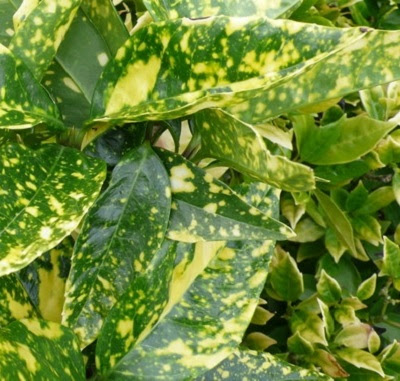 |
| Aucuba japonica 'Crotonifolia' |
Aucuba japonica 'Crotonifolia' is a popular, hardy, evergreen shrub, noted for its robust constitution and ornamental foliage. The type species was first brought the attention of European gardens by German botanist and nurseryman John Graefer (1746–1802), gardener to the King of Naples at the Palace of Caserta. Incidentally, Graefer was previously a pupil of the celebrated English botanist Philip Miller, chief gardener at the Chelsea Physic Garden, London, and one of the most prominent botanical gardens of Europe during the 18th century.
The genus was named by Swedish naturalist Carl Peter Thunberg (1743–1828), an apostle of Carl Linnaeus who was considered to be the father of modern taxonomy.
Aucuba japonica 'Crotonifolia' has proven to be extremely tough under garden conditions, thriving in city air pollution, dry shade, and salt-laden coastal winds.
The glossy leathery leaves are between 15-20 cm long, narrowly ovate and widely toothed towards the apex. Aucuba japonica species and their cultivars are dioecious, meaning that male and female flowers are borne on separate plants. The Aucuba japonica 'Crotonifolia' is male which, unlike the popular 'Variegata' cultivar, means that it will not produce blooms of the attractive, ornamental red berries.
Under favourable conditions you can expect Aucuba japonica 'Crotonifolia' to reach an overall height of 2-4 metres and width of 2-3 metres. While the type species natural habitat includes rich forest soils of moist valleys, thickets, by streams and near shaded moist rocks, garden specimens will be happy growing in full sun to partial shade, in most moist but well-drained soils.
As well as the garden, it is suitable for growing in urns or other containers in a shady courtyard, and may even be grown as houseplant in well-lit halls and patio gardens.
Aucuba japonica 'Crotonifolia' received the Award of Garden Merit from the Royal Horticultural Society in 1984.
 |
| Aucuba japonica 'Crotonifolia' |
Aucuba japonica 'Crotonifolia' has proven to be extremely tough under garden conditions, thriving in city air pollution, dry shade, and salt-laden coastal winds.
The glossy leathery leaves are between 15-20 cm long, narrowly ovate and widely toothed towards the apex. Aucuba japonica species and their cultivars are dioecious, meaning that male and female flowers are borne on separate plants. The Aucuba japonica 'Crotonifolia' is male which, unlike the popular 'Variegata' cultivar, means that it will not produce blooms of the attractive, ornamental red berries.
Under favourable conditions you can expect Aucuba japonica 'Crotonifolia' to reach an overall height of 2-4 metres and width of 2-3 metres. While the type species natural habitat includes rich forest soils of moist valleys, thickets, by streams and near shaded moist rocks, garden specimens will be happy growing in full sun to partial shade, in most moist but well-drained soils.
As well as the garden, it is suitable for growing in urns or other containers in a shady courtyard, and may even be grown as houseplant in well-lit halls and patio gardens.
Aucuba japonica 'Crotonifolia' received the Award of Garden Merit from the Royal Horticultural Society in 1984.
For related articles click onto the following links:







No comments:
Post a Comment